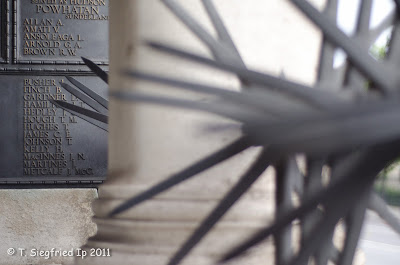This exercise requires me to take a series of image of a moving object (or objects) at different shutter speeds. It should be quite obvious that it will introduce motion blur if the shutter speed is slow enough. My questions are as follow:
1) We are going to hit slow shutter speed, but how slow do we need? What is the balance between blur and detail?
2) Can I get good image even in the case when the motion blur is not obvious (ie relative fast shutter speed.
In order to answer the first question, I need some sort of way to measure the speed of the object, even at a pseudo science level. Sadly, I don’t have a speedometer. After some thought I think I can make use of somewhere that has a strictly reinforced speed limit.
There is at least one infamous place where police cameras are set up at the entrance and exit. The urban legend is they use the images before and after to check the time for your car to pass. If your image shows up at the exit too early, you will get a speeding ticket in mail. Not only that, I was told that it follows up with a two and a half hours of speed awareness workshop.
The speed limit is only 20m/h. Most people are driving at the speed limit unless there is a jam ;)
We can also approximate the field of view of the camera, the length of the Tower Bridge can be found in first image in Wikipedia (http://en.wikipedia.org/wiki/File:Tower_bridge_schm020.png)
Cool, let's rock and roll.
So I start with this image.
Hmm, I don't like it.
Look, the intention here is clear. At the end I want to take pictures at slow shutter speed so that I can see the trace of light on the road. At slow shutter speed, it makes sense. At 1/50s, this picture is just boring.
Ok. I am flipping it around. I actually have nice background here. Why don't I get some of it? The end result is something like this:
The speed limit is only 20m/h. Most people are driving at the speed limit unless there is a jam ;)
We can also approximate the field of view of the camera, the length of the Tower Bridge can be found in first image in Wikipedia (http://en.wikipedia.org/wiki/File:Tower_bridge_schm020.png)
Cool, let's rock and roll.
So I start with this image.
Image 1: 28mm f/5.6 ISO 800 at 1/50s
Hmm, I don't like it.
Look, the intention here is clear. At the end I want to take pictures at slow shutter speed so that I can see the trace of light on the road. At slow shutter speed, it makes sense. At 1/50s, this picture is just boring.
Ok. I am flipping it around. I actually have nice background here. Why don't I get some of it? The end result is something like this:
Image2: 28mm f/32 ISO 100 at 10sec
Better. But why I feel everything leaning on the right?
Here is a problem. I think I am not accustom to look around at the frame enough. I know what I am trying to get, I just shoot and miss the details. Damn.
Let's start all over again before it gets too dark. I will move my camera a little bit. We start with fast(er) shutter and go down.
Image 3: 28mm f6.3 ISO 800 at 1/20s
Image 4: 28mm f/6.3 ISO 400 at 1/10s
Image 5: 28mm f/6.3 ISO 200 at 1/5s
Image 6: 28mm f6.3 ISO 100 1/3s
Image 7: 28mm f/11 ISO 100 at 1.3s
Image 8: 28mm f/16 ISO 100 at 2.5s
Image 9: 28mm f/20 ISO 100 5sec
Image 10: f2.8 f/32 ISO 100 10sec
Even with this composition, the picuture is still slightly heavy on the right hand side. I reckon the best to do this shot is in the middle of the road between two lanes with a wide angle lens, so that the tower is at the middle. Of course, I will get arrested if I set up a tripod there. I move the tower as close to centre of the frame as possible. There is a trade off: because I am clearly on one side of the road, if I force the tower to centre, I will get least light from the car but more stupid people who leaning on the fence taking picture (As you can see, there are shadows around the lower right corner). Of course I can keep the overall exposure darker so that those shadow are darker and blend into the background. But then there is another trade off. If the overall exposure is darker, the details on the first tower look darker as well.
You really can't have it all, unless, you buy up the whole town : D
Last but not the least, the whole idea to get to somewhere with speed limit is to compare that to shutter speed. So how are we doing? From the diagram from Wikipedia and the photographs taken is about 2/3 of 270 feet (82m), which is roughly 54m. The 20mph speed limit translate to roughly 9m/s. As a result it takes a car slightly less than 7 seconds to get through the frame. This is consistent with the result we see: We can almost unbroken beam across the frame at 5s and 10s exposure. Notice that in image 10 I was already at f/32 and ISO 100, therefore, I can't really run the camera any slower without risk of over-exposing the photograph while getting a continuous light beam.






































